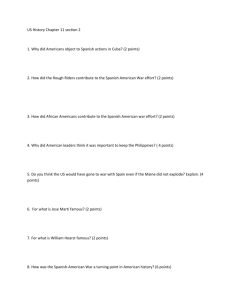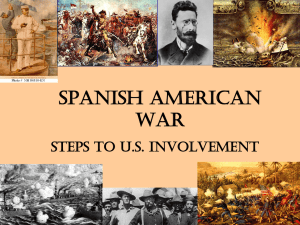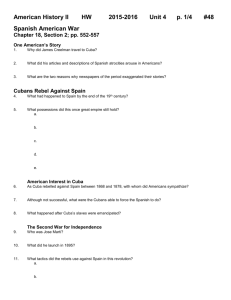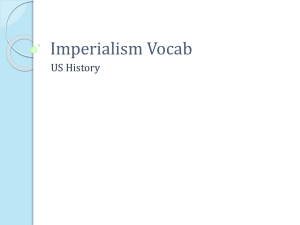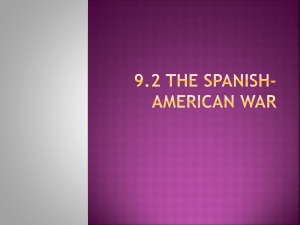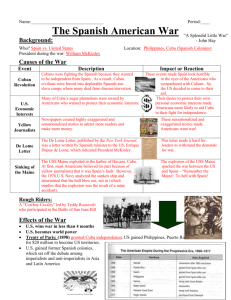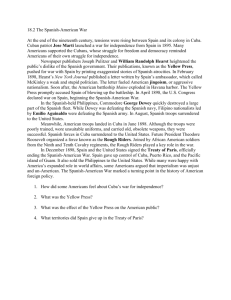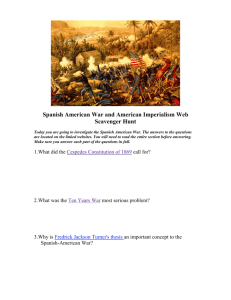36EraofTheodoreRoosevelt
advertisement
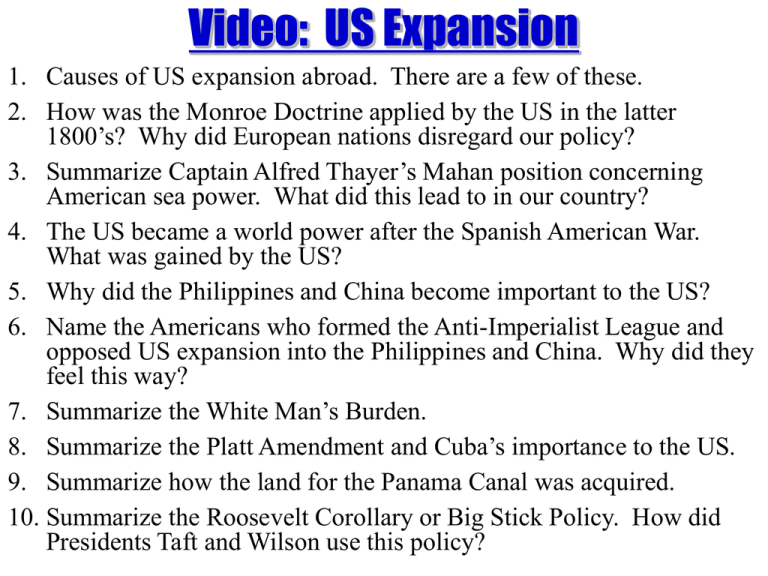
Video: US Expansion 1. Causes of US expansion abroad. There are a few of these. 2. How was the Monroe Doctrine applied by the US in the latter 1800’s? Why did European nations disregard our policy? 3. Summarize Captain Alfred Thayer’s Mahan position concerning American sea power. What did this lead to in our country? 4. The US became a world power after the Spanish American War. What was gained by the US? 5. Why did the Philippines and China become important to the US? 6. Name the Americans who formed the Anti-Imperialist League and opposed US expansion into the Philippines and China. Why did they feel this way? 7. Summarize the White Man’s Burden. 8. Summarize the Platt Amendment and Cuba’s importance to the US. 9. Summarize how the land for the Panama Canal was acquired. 10. Summarize the Roosevelt Corollary or Big Stick Policy. How did Presidents Taft and Wilson use this policy? 1. US Looks Abroad Imperialism and its factors The New Manifest Destiny Isolationism vs expansionism 2. Lands acquired by U.S. 3. Spanish American War---1898 "Splendid Little War" Causes and effects notes1 3 D’s •Duty, Dollars, Destiny •spread our culture •Christianity •new markets 4. Importance of Asian market 1899-1902: Philippine Question Filipino Revolution—3 years to put down Open Door Policy Chinese trade Spheres of influence Boxer Rebellion 1899-1900 TR vs Japan Russian Japanese War---1904 Gentlemen’s Agreement, 1906 5. 1904, Roosevelt Corollary “Big Stick Policy” protect U.S. interests = Asia and Latin America Panama Canal notes2 6. Pres. Taft & Wilson: Dollar Diplomacy U.S. banks and businesses invest. "Big Stick policy”: Wilson intervenes Haiti: 1914-1934 Dominican Republic: 1916-1924 Mexico to get Pauncho Villa in 1916 notes3 Under imperialism, stronger nations attempt to create empires by dominating weaker nations. The late 1800s marked the peak of European imperialism, with much of Africa and Asia under foreign domination. A policy of extending your rule over foreign countries A major departure of the US policy of “isolation” to involvement in world affairs. What are the factors involved in a country becoming imperialists? Economic The growth of industry increased the need for natural resources. Commerce New markets and expansion of trade into Asia & Latin America. Nationalistic European nations competed for large empires was the result of a rise in nationalism Military Europe had better armies than Africa and Asia, and it needed bases around the world to refuel and supply navy ships. Humanitarian Desire/duty to spread western civilizations to other countries. The New Manifest Destiny Trade into Asia & Latin America Keep up with Europe Annex strategic islands in the S. Pacific and Caribbean Sea. Trade center of the world Build a canal International policeman Large naval presence Commercial/Business Interests American Foreign Trade: 1870-1914 2. Military/Strategic Interests Alfred T. Mahan The Influence of Sea Power on History: 1660-1783 Expanding U.S. Interests The Monroe Doctrine • Originally meant that the United States declared itself neutral in European wars and warned other nations to stay out of the Western Hemisphere. • Later, the doctrine was interpreted to mean a more active role to protect the interests of the United States. FOR EXPANSION AGAINST EXPANSION ■Keep up with European nations ■Desire for prestige ■Theory of racial superiority ■Provide market for surplus goods and investments ■America’s vastness provided enough of an outlet for the country’s energies ■America should not rule over other peoples Imperialists •Theodore Roosevelt •William Mckinley •William Randolph Hearst •Joseph Pulitzer Anti-Imperialist League •Mark Twain •Andrew Carnegie •Susan B. Anthony European nations colonizing--US needed to do the same or become an insignificant county…… CartoonEuropea n grab bag CartoonEuropean grab bag CartoonEuropean grab bag US goal was always expansion Cartoon-US Expansion1 Social Darwinist Thinking The Hierarchy of Race The White Man’s Burden: to civilize the world Religious/Missionary Interests American Missionaries in China, 1905 Expanding U.S. Interests Seward’s • In 1867, Secretary of State William Seward Folly bought Alaska from Russia. Midway • Seward bought the uninhabited Midway Islands for use as repairing and refueling stations for navy vessels in the Islands Pacific. • The United States signed a treaty with Hawaii and took a Latin more active role in protecting Latin America. America, • US policy would expand into the Philippines and Hawaii negotiate trade treaties. and Asia Seward’s Icebox: 1867 Island Possessions Hawaiian Queen Liliuokalani Hawaii for the Hawaiians! U. S. Business Interests In Hawaii 1875 – Reciprocity Treaty 1890 – McKinley Tariff 1893 – American businessmen backed an uprising against Queen Liliuokalani. Sanford Ballard Dole proclaims the Republic of Hawaii in 1894. The Spanish-American War Steps • Spanish brutality towards Cubans •The Butcher---Valeriano Weyler to War • Yellow Press/Journalism----Sensational • Spanish Ambassador de Lôme insulted President McKinley. • The USS Maine exploded, and the American public blamed Spain. • Congress recognized Cuban independence and authorized force against Spain. •Teller Amendment: US was fighting this war to help Cuba gains its independence and would not seek any land gains from Cuba. • War is declared April 17, 1898 Joseph Pulitzer William Randolph Hearst •Both imperialists and wanted war with Spain. •Their “Yellow Press” propaganda led Americans to support war with Spain. •Spain controlled Cuba since 1500’s. •Cuban people were fighting a revolution against Spanish brutality •Cubans wanted their independence from Spain •90 miles from U.S. •Protect our trade •American citizens threatened by revolution in Cuba. •Pres. McKinley sent USS Maine to rescue US citizens. •USS Maine---260 US sailors killed •Spain accused of blowing up the Maine….. •Polarized Americans to support the war against Spain. •Hearst was heard to say, “Supply me with pictures and I’ll give you a war”. Yellow Press Yellow Press •Joseph Pulitzer and William Randolph Hearst were popular newspaper editors trying to sell newspapers. •Expansionist’s war with Spain. •Hearst was heard to say, “Supply me with pictures and I’ll give you a war”. Yellow Press The Spanish-American War • May 1, 1898: The United States “A launched a surprise attack in Manila Splendid Bay and destroyed Spain’s entire Little Pacific fleet in seven hours. War” • July 1: Roosevelt led the Rough Riders up San Juan Hill. • July 3: The United States Navy sank the remaining Spanish ships. SP War in Pacific SP War in Pacific Dewey Captures Manila! SP War in Caribbean •Captured San Juan Hill which led to the end of the war once Santiago was surrendered by the Spanish. Rough Riders •Became a hero of the Spanish American War. Rough Riders The Spanish-American War • With Spain’s defeat their government The recognized Cuba’s independence. Treaty • Spain gave up the Philippines, Guam, and of Puerto Rico to the US in return for $20 Paris, million. 1898 • The island nations then became unincorporated territories of the United States. • President McKinley installed a military government to protect American business interests. The Spanish-American War Puerto •Puerto Rico strategic post in Caribbean, for protection of future canal Rico •1900, Foraker Act sets up civil government and - president appoints governor, upper house Cuba •1917, Puerto Ricans made U.S. citizens; elect both houses •President McKinley installed a military government to protect American business interests. •Cuba drafted a constitution in 1900 that did not allow for U.S. involvement. •The U.S. government only agreed to remove its troops if Cuba included the Platt Amendment. •The Platt Amendment remained in place until 1934. It allowed for U.S. naval bases on the island and intervention whenever necessary. •Spanish and American War was referred to as a “Splendid Little War” •Cost of war in terms of loss of life and money was minimal •US became a world power as a result of this war. •Gained the following areas: •Philippines •Guam •Puerto Rico Cartoon-Sp & US War
